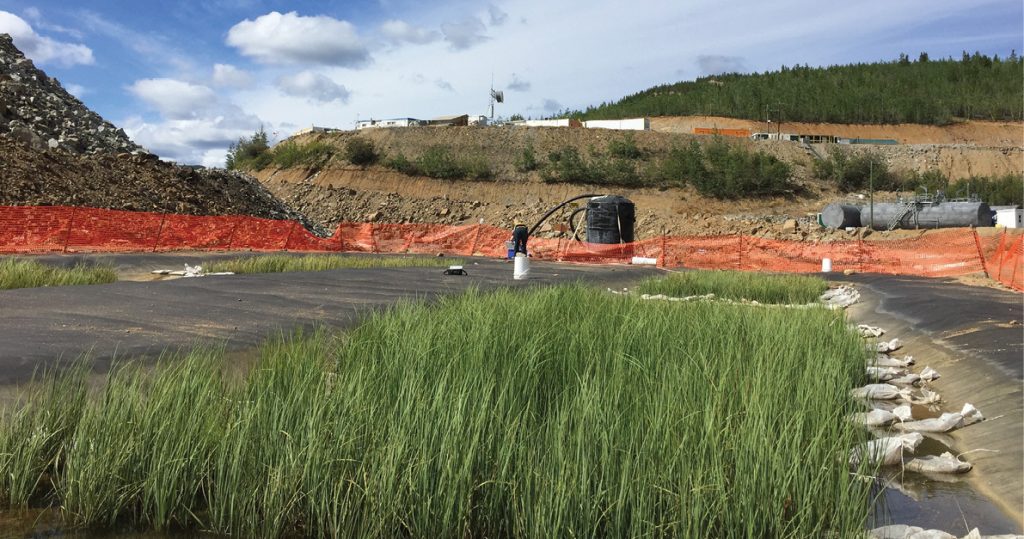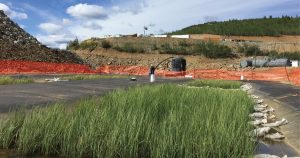Sponsored: New technology evolves passive water treatment


 The Minto Mine constructed wetland treatment system (Yukon, Canada) was designed and built by Dr. Monique Simair. The system has been operational as an on-site pilot at demonstration-scale since 2014 treating selenium, copper, nitrate, and other metals and metalloids. Credit: Monique Simair[/caption]
The Minto Mine constructed wetland treatment system (Yukon, Canada) was designed and built by Dr. Monique Simair. The system has been operational as an on-site pilot at demonstration-scale since 2014 treating selenium, copper, nitrate, and other metals and metalloids. Credit: Monique Simair[/caption]
As we all strive towards more sustainable practices, Canada’s mining industry is held to some of the highest environmental standards in the world. Thanks to new research and technology, water treatment techniques are advancing at an unprecedented rate, unlocking new treatment solutions that are emerging at the forefront of international ‘best practices’. One such group of modern technologies are collectively referred to as “semi-passive” water treatment. This includes constructed wetland treatment systems, biochemical reactors such as gravel bed bioreactors, and in situ treatment (treatment at the source) such as pit lake and flooded underground mine pool treatment.
Water treatment solutions have traditionally been categorized into active or passive treatments. Active water treatment typically uses electricity, reagents, and usually requires buildings and facilities, increasing the overall carbon footprint of water treatment. Passive treatments often come in at the other side of the spectrum using no energy or chemical inputs and require no operational management. While this approach has been used successfully in a few cases, these passive systems generally come with a high degree of unpredictability that can be difficult to manage. Considering the positive impact passive treatments can have on both the environment and operating costs, Maven Water and Environment (Maven) has developed leading technologies and proprietary software that have transformed traditional passive applications.
Emerging Semi-Passive Treatments
Though the term “passive treatment” has been used to describe many different things, in recent years it has evolved to more commonly mean “Semi-Passive treatment”. With recent research and technology advances, operationally passive treatments have adapted to include periodic monitoring and maintenance. These treatments involve the merging of multiple technical disciplines, including biogeochemistry, microbiology, geochemistry, and hydrology, and multiple areas of engineering that are applied to a wide range of treatment applications. Similar to active water treatment systems, semi-passive water treatment systems are also often built as ‘treatment trains’ with multiple different technologies or design aspects integrated in a specific order to provide the best water quality with the greatest ease and predictability.
Semi-passive treatment systems have defined ranges of operating parameters and can be maintained through adaptive management programs. These systems are often managed through in situ monitoring and remote data uplinks. In some cases, semi-passive water treatment can be further augmented or enhanced. These enhanced semi-passive treatments can include remote operational control over responsive management triggers like flow management or adding carbon or neutralizing reagents.
All of these semi-passive treatment options are based on the scientific principles of biogeochemistry which is a specialty that combines microbiology, geology, and chemistry. These types of biogeochemical treatment systems used to be considered as a “black box”, because of the microbiology involved. Many practitioners and consultants don’t know that it has been possible for nearly a decade to analyze these microbial populations through routine analysis at commercial labs. This is the key to understanding, optimizing, and de-risking the treatment processes.
Treatment wetlands are perhaps the most commonly recognized form of semi-passive water treatment, and they are known by many different names. While they might look similar to an untrained eye, a treatment wetland designed to treat metals from mining impacted water is almost entirely different from designs that are used to treat municipal effluents. For example, it’s a common misconception that the plants in the wetland treat the water, when in fact, it’s the microbes in the sediments that do the heavy work. If a plant is taking up metals, there’s likely a problem with the treatment system design or function.
Semi-passive treatment systems are a proven technology for both operations and closure at mines. Just like active water treatment systems they require site-specific design and operation. Active treatment systems control for many parameters using energy inputs (e.g., temperature, flow, chemistry, etc), whereas semi-passive treatment systems need to account for parameter variability through robust system design. This means that optimizing for site-specific aspects can sometimes take longer for semi-passive treatment than for active treatment.
Conceptual Feasibility and Modelling
Conceptual modelling and feasibility studies are often done in consideration of the site-wide water management plan, in order to develop a strategy for each individual water source. This is somewhat in contrast to active treatment approaches, where all water is gathered together, and additional energy and chemical inputs are needed to overcome the challenges brought on by combining water sources and volumes. Semi-passive water treatment treats water as close to the source as possible and enables industry best practices of contamination prevention and source control. These principles are applied to achieve a decentralized treatment approach that results in the best possible water quality, with the lowest energy inputs. Given the complexities for modelling, design optimization, and scaling semi-passive treatments, Maven developed a unique software package called mGuide. mGuide takes complex datasets, such as long-term datasets or predictively modelled source term outputs for every node of a mine site and evaluates the opportunities and risks for semi-passive treatment across a mine site. We can now also identify aiding and inhibiting constituents in the water for the semi-passive treatment system and include these in the operating considerations or risk mitigation strategies.
After the conceptual modelling is done to determine the best technologies and their applications to locations on site, it is then necessary to refine sizing and treatment predictions with site-specific information.
Site-specific Optimization
The first step in site-specific optimization of a design is often to fill in data gaps with additional laboratory analysis of site water chemistries or simple ‘bench scale’ trials. This scale is generally informative to the conditions and treatability of the water, but not informative to the design itself.
Pilot-scale trials are generally undertaken to inform site-specific design considerations and develop adaptive management programs to de-risk operations. These can be done on-site or off-site. The choice between off-site and on-site trials depends on many factors. If pilot testing is being done off-site, it is important that the facility has the ability to run the tests at a climate that is relevant to the site and to mimic the comprehensive water chemistries. Maven opened a pilot-scale testing facility in summer 2020 with unique capabilities for semi-passive and active water treatment testing, paired with microbiology and biogeochemistry laboratories. This allows Maven to get inside the ‘black box’ and provide deep understanding of the treatment processes and optimizations.
On-site pilot-scale testing can often have lengthy timelines and high costs for construction, commissioning, and testing. To address these challenges, Maven has developed a new mobile pilot-scale testing system – called mFlex – that can be built to include site-specific designs and commissioned in our off-site pilot facilities before being shipped on-site for site-specific testing and optimization.
Scaling to full-size and developing operating plans
Once the necessary information is collected on site-specific aspects, modelling can be done for the full-scale system (or integrated treatment train). Site-specific data is used in the mGuide to allow for unique scaling considerations. Although this used to be done with notebook calculations and excel files, the application of big data enables more accurate modelling and risk analysis than ever before. This enables not only the detailed design and accurate scaling of the treatment system, but also the refinement of the adaptive management program and response actions.
Maven Water and Environment is paving the way in semi-passive research, technology, and application, creating water treatment solutions that are effective, transparent, and trustworthy.
If you are interested in learning which type of active or semi-passive water treatment technology can support the constituent you are interested in, the new mScout app can help with this, and is free to use at mscout.mavenwe.com.
For more information visit www.mavenwe.com.
Comments